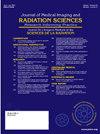Evaluation of a novel mask balloon immobilization system for reducing intra-fractional setup errors in spinal stereotactic body radiation therapy
IF 1.3
Q3 RADIOLOGY, NUCLEAR MEDICINE & MEDICAL IMAGING
Journal of Medical Imaging and Radiation Sciences
Pub Date : 2025-07-03
DOI:10.1016/j.jmir.2025.102016
引用次数: 0
Abstract
Background
Accurate immobilization is vital in spinal stereotactic body radiation therapy (SBRT) to minimize intra-fractional setup errors (IntraSE) and optimize therapeutic outcomes. Traditional methods, such as evacuated cushions, may lack sufficient stability, highlighting the need for improved systems. This study evaluates the accuracy and efficacy of a mask-balloon immobilization system, combining a body mask and a specialized balloon, for spinal SBRT.
Methods
Seventy-five patients undergoing spinal SBRT for thoracic or lumbar metastases were analyzed. Of these, 40 patients were immobilized using an evacuated cushion, while 35 used the mask balloon system. Cone-beam computed tomography (CBCT) scans were acquired three times during treatment, and the bony anatomy registration measured translational setup errors in anterior-posterior (AP), superior-inferior (SI), and right-left (RL) directions.
Result
For the evacuated cushion, the mean ± standard deviation of absolute IntraSE post-first arc was 0.4 ± 0.7 mm (AP), 0.5 ± 0.7 mm (SI), and 0.5 ± 0.6 mm (RL). For the mask-balloon system, the corresponding values were 0.2 ± 0.2 mm, 0.3 ± 0.3 mm, and 0.3 ± 0.3 mm. After treatment completion, the IntraSE values were 0.7 ± 0.9 mm, 0.8 ± 0.9 mm, and 0.9 ± 0.8 mm for the evacuated cushion and 0.4 ± 0.3 mm, 0.4 ± 0.4 mm, and 0.6 ± 0.4 mm for the mask-balloon system. In all three translational directions, the mask-balloon system had a significantly smaller IntraSE than the evacuated cushion (p < 0.0001).
Conclusion
The mask-balloon system improves setup accuracy and is a promising immobilization system for spinal SBRT.
评估一种新型的面罩球囊固定系统,以减少脊柱立体定向放射治疗中分数内设置错误
背景:在脊柱立体定向放射治疗(SBRT)中,准确的固定对于减少片段内设置错误(IntraSE)和优化治疗结果至关重要。传统的方法,如真空缓冲垫,可能缺乏足够的稳定性,这突出了改进系统的必要性。本研究评估了面罩-球囊固定系统的准确性和有效性,该系统结合了身体面罩和专门的球囊,用于脊柱SBRT。方法对75例胸腰椎转移性肿瘤行脊柱SBRT的患者进行分析。其中,40例患者使用疏散垫固定,35例使用面罩气囊系统。治疗期间进行了三次锥形束计算机断层扫描(CBCT),骨解剖配准测量了前后(AP)、上下(SI)和左右(RL)方向的平移设置误差。结果真空缓冲垫的绝对IntraSE首弧平均±标准差分别为0.4±0.7 mm (AP)、0.5±0.7 mm (SI)和0.5±0.6 mm (RL)。对于掩模-气球系统,对应的值分别为0.2±0.2 mm、0.3±0.3 mm和0.3±0.3 mm。治疗结束后,真空缓冲垫的IntraSE值分别为0.7±0.9 mm、0.8±0.9 mm和0.9±0.8 mm,掩膜气囊系统的IntraSE值分别为0.4±0.3 mm、0.4±0.4 mm和0.6±0.4 mm。在所有三个平移方向上,掩膜气球系统的IntraSE明显小于真空垫(p <;0.0001)。结论面罩-球囊系统提高了固定精度,是一种很有前途的脊柱SBRT固定系统。
本文章由计算机程序翻译,如有差异,请以英文原文为准。
求助全文
约1分钟内获得全文
求助全文
来源期刊

Journal of Medical Imaging and Radiation Sciences
RADIOLOGY, NUCLEAR MEDICINE & MEDICAL IMAGING-
CiteScore
2.30
自引率
11.10%
发文量
231
审稿时长
53 days
期刊介绍:
Journal of Medical Imaging and Radiation Sciences is the official peer-reviewed journal of the Canadian Association of Medical Radiation Technologists. This journal is published four times a year and is circulated to approximately 11,000 medical radiation technologists, libraries and radiology departments throughout Canada, the United States and overseas. The Journal publishes articles on recent research, new technology and techniques, professional practices, technologists viewpoints as well as relevant book reviews.
 求助内容:
求助内容: 应助结果提醒方式:
应助结果提醒方式:


